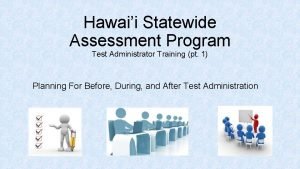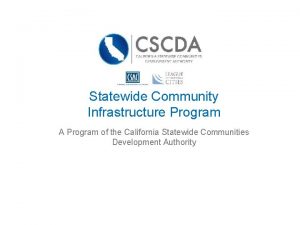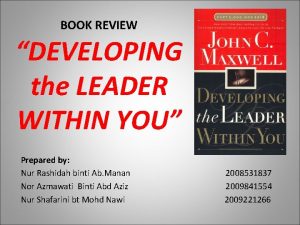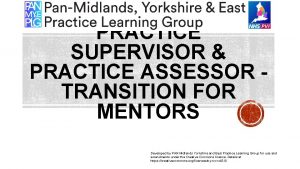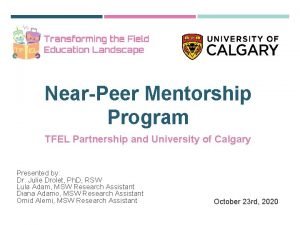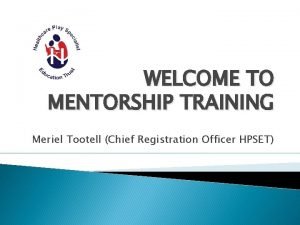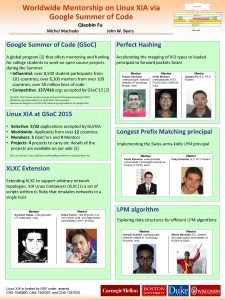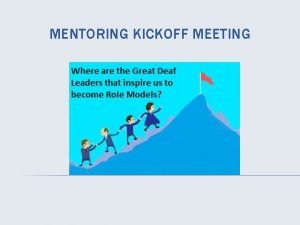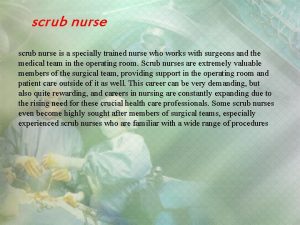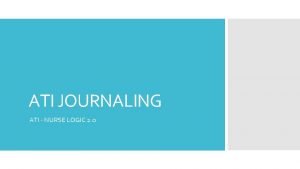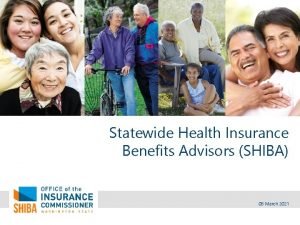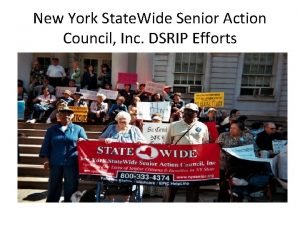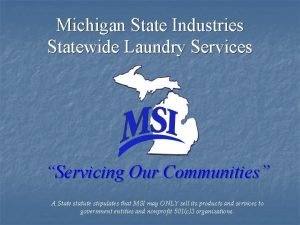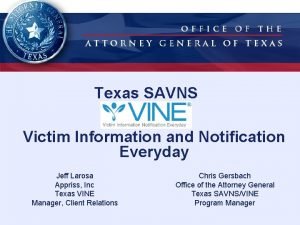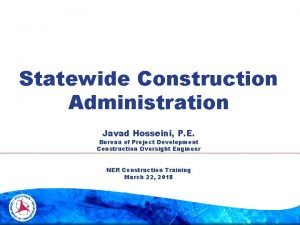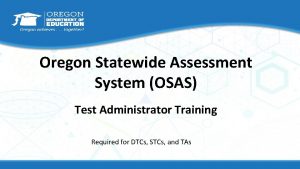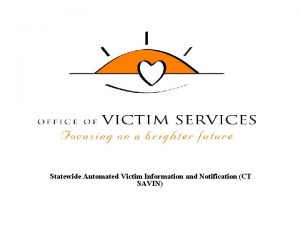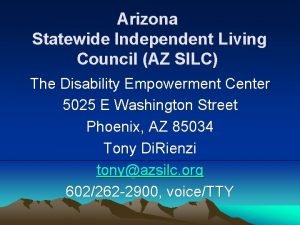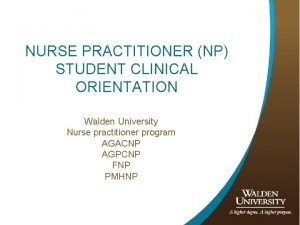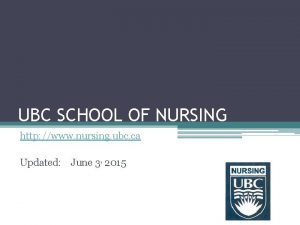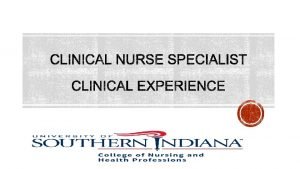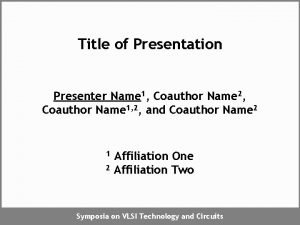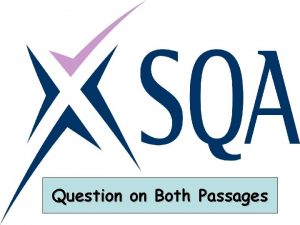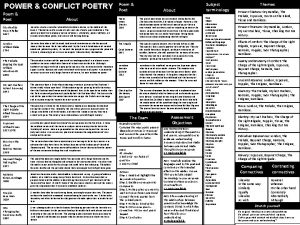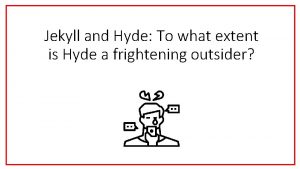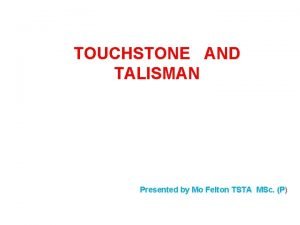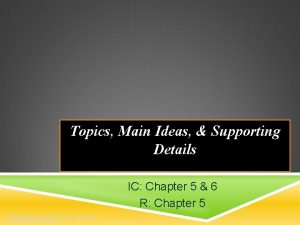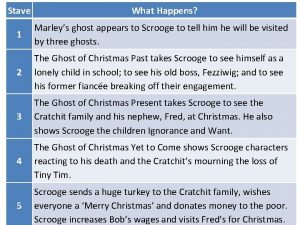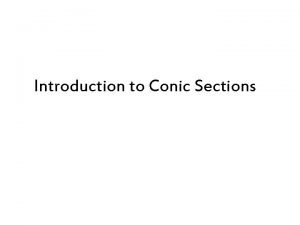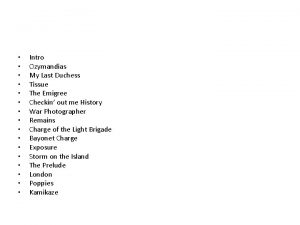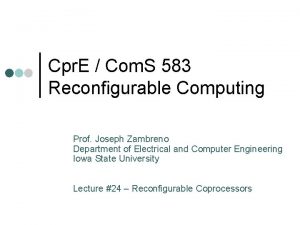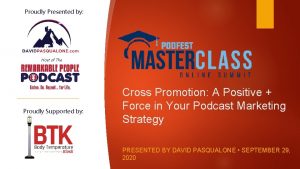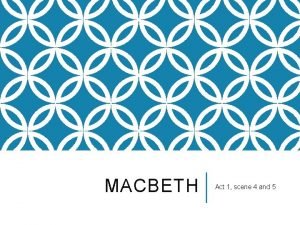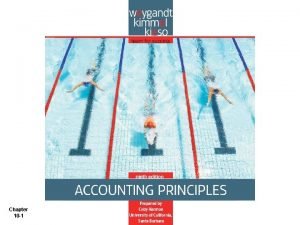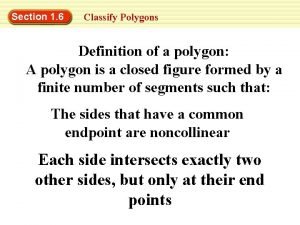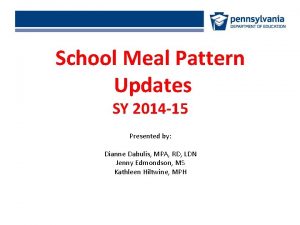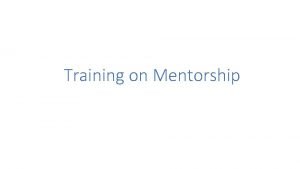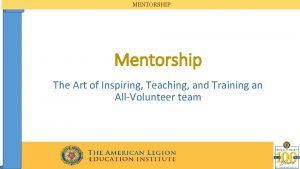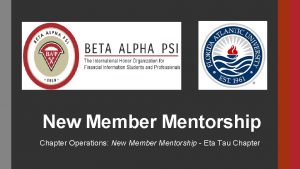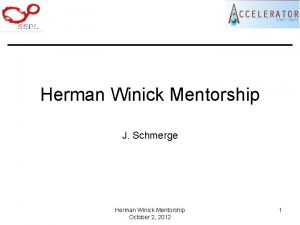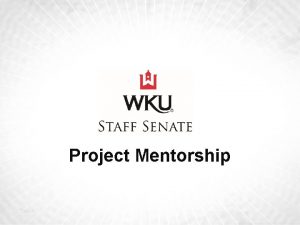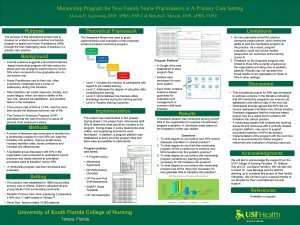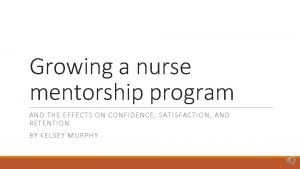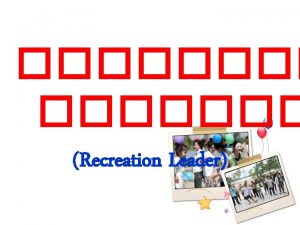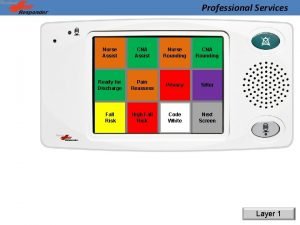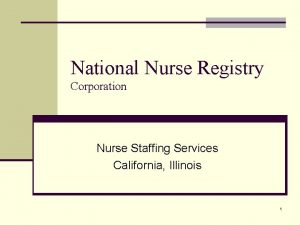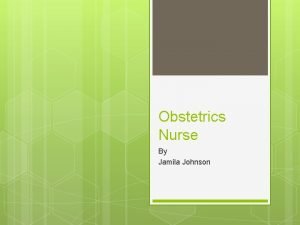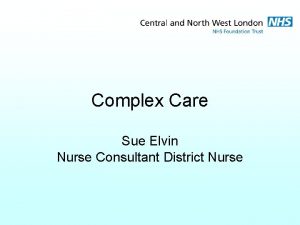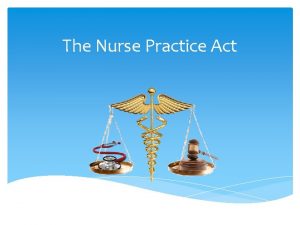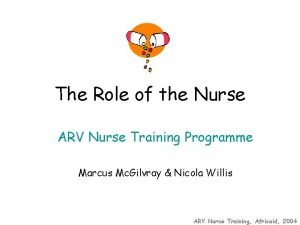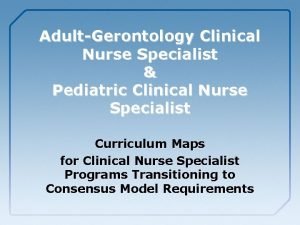DEVELOPING A STATEWIDE NURSE LEADER MENTORSHIP PROGRAM Presented





























































- Slides: 61

DEVELOPING A STATEWIDE NURSE LEADER MENTORSHIP PROGRAM Presented by: Tracy Vitale, DNP, RNC-OB, C-EFM, NE-BC Organization of Nurse Leaders of NJ Chair – Mentorship Committee April 6, 2018

Additional Credits: Mary Jo Loughlin, MAS, RN, NE-BC Mary Rich, MSN, MAS, RN, NE-BC, CCRN

OBJECTIVES § Identify the process for development of a nurse leader mentorship curriculum and implementation of a statewide program. § Apply the tools and methods to initiate a mentorship program in other healthcare organizations and state AACN chapters. § Correlate the value of the mentorship program with AACN, AONE, IOM, and Magnet standards supporting nurse leader growth and development.

ORGANIZATION OF NURSE LEADERS OF NJ § Established 1971 as the Organization of Nurse Executives of New Jersey (ONE NJ) § Voice of Nursing Leadership in NJ § Membership: nearly 600 current & aspiring Nurse Leaders § Represents 90% of NJ hospitals § Headquarters: New Jersey Hospital Association (NJHA) in Princeton, NJ

MENTORING Classic nursing definition of mentoring by Bowen (1985): § senior person (the mentor) provides information, advice, and emotional support to the junior person (the mentee). § extended period of time and marked by substantial emotional commitment by both partners. § If the opportunity presents itself, the mentor also uses both formal and informal forms of influence to further the career of the mentee.

MENTORING § Another nursing leader, Linda Yoder, accepted Bowen’s definition of Mentorship, expanded the concept, and defined six critical attributes to the mentoring process including a: 1) Teaching and learning process 2) Reciprocal role 3) Career development relationship 4) Knowledge or competence differential between participants 5) Duration of several years 6) Resonating phenomenon Yoder (1990)

MENTORING § Findings: Individuals experiencing extensive mentoring relationships reported receiving: § Promotions § Higher incomes § Greater satisfaction with pay and benefits than individuals experiencing less extensive mentoring relationships (Dreher & Ash, 1990)

MENTORING § Chung & Kowalski, 2012 § Study results demonstrated 40% of the sample had a current work mentor. § Variables showed significant relationships to: § Job satisfaction (p < 0. 01) § Job stress (p < 0. 01) § Psychological empowerment (p < 0. 01)

MENTORING ONL NJ embarked on a multi-year journey to create a structured mentorship program for the development of current and aspiring nurse leaders in alignment with the: § American Organization of Nurse Executives § Institute of Medicine § American Nurses Credentialing Center § American Association of Critical-Care Nurses

MENTORING Institute of Medicine § Recommendation 7: Prepare and enable nurses to lead change to advance health. § Nursing associations should provide leadership development, mentoring programs, and opportunities to lead for all members. .

MENTORING American Organization of Nurse Executives § Mission: To shape health care through innovative and expert nursing leadership § Launched AONE Leader 2 Leader Mentorship Program § Matches mentors and mentees based on AONE core competencies

MENTORING AONE 2016 -2018 Priorities § Priority 1: Develop core competencies of nurse leaders across the care continuum to support current and emerging roles. § Priority 4: Communicate the value of nursing in health care across the continuum to all stakeholders.

MENTORING AONE Priority 1 Strategies § 1 A: Utilize the AONE competencies to develop resources that ensure nurse leaders across the care continuum have the core competencies needed to lead in the changing health care environment. http: //www. aone. org/docs/About/aone-strategic-plan. pdf

MENTORING AONE Priority 1 Strategies § 1 B: Create innovative leadership and governance development programs that provide nurse leaders with the skills and knowledge needed to effectively serve, across the care continuum and throughout the global community. http: //www. aone. org/docs/About/aone-strategic-plan. pdf

MENTORING AONE Priority 1 Strategies § 1 C: Accelerate adoption of innovative best practices through educational resources, tools and leadership development for nurse leaders at all stages of their careers, across the care continuum. http: //www. aone. org/docs/About/aone-strategic-plan. pdf

MENTORING American Nurses Credentialing Center (ANCC) § Pathways to Excellence § Magnet Standard: Transformational Leadership § Focus on mentoring & succession planning

MENTORING Nurse leaders from several healthcare systems throughout the state established and developed the initial structure for a statewide mentorship program and included: § Chief Nurse Executives § Assistant Vice Presidents § Nurse Directors

MENTORING § The first cohort was launched in 2011 with a call for mentors and mentees from the ONL NJ membership. § Potential mentors and mentees were required to submit a resume and complete a Myers-Briggs Personality Assessment. § Mentors listed management strengths. § Mentees listed areas for development.

MENTORING § With the data submitted from the mentors and mentees, the Mentorship Committee began the matching process. § Some committee members recommended matching like personalities, others proposed matching opposite personalities. § Since there was a lack of consensus, the Committee did not use the Myers-Briggs Personality Assessment for matching.

MENTORING Development of Mentorship Liaison Role § One Mentorship Committee member was assigned to serve as a liaison for each mentor-mentee pair. § The liaisons periodically check-in with their assigned pair to inquire how the mentee/mentor relationships were developing. § The liaisons were available to the dyad for issues and concerns.

MENTORING § We matched by request of mentee to the role he/she desired to be mentored by; examples are: Mentee Mentor Director CNO Nurse Manager Director Nurse Educator Seasoned Educator New Researcher Seasoned Researcher New Bed Manager Seasoned Bed Manager § Nursing specialty and geographic location were also considered.

MENTORING § Guidelines were developed for the frequency of mentor-mentee meetings. § Cohort I launched with 11 pairs. § Based upon extremely positive feedback from the liaisons, the Committee launched Cohort II. § The Myers-Briggs Tool was not used. § Pairs were matched based upon the mentee request, type of mentor position desired, and specialty.

MENTORING § The second cohort did not go as well. § Some pairs never connected. § One match was not good and the mentee did not know who to report to. § The remaining pairs reported a positive experience.

MENTORING § The Mentorship Committee recognized the need to reevaluate the program. § With the assistance of the ONL NJ Research Committee and the doctoral prepared nurses in the organization, the Mentorship Committee recommended a qualitative research study.

QUALITATIVE RESEARCH STUDY § Interviews via focus groups at the New Jersey Hospital Association: § 5 mentees § 4 mentors § Data collection conducted via audio-taped records and transcribed verbatim by professional transcription services. § Only the research facilitators and the ONL NJ Executive Director were permitted to hear tapes and read the transcripts.

FOCUS GROUP QUESTIONS § What was your role in the mentor/mentee relationship? § Tell me about your experience overall. § What did you learn from the mentor/mentee experience? § What are your thoughts about continuing the program for future mentor/mentee pairs? § What would you have liked to experience differently?

QUOTES § “I have enjoyed the mentorship program. I have learned a lot and it is nice having someone with so much experience to mentor me. ” § “Mentoring has been a hallmark of my success. Therefore, I believe in mentoring and think all employees, particularly nurses should receive mentoring. ” § As the mentor, I was pleasantly surprised to gain as much as I gave during the mentoring process. ”

RESEARCH STUDY RESULTS THEMES § Making a Connection § Giving and Getting § Emotional Roller Coaster § Logistics § It Can’t be Forced SUB-THEMES § Safety § Boundaries § Strangers

RECOMMENDATIONS § Design educational session § Reevaluate/restructure matching process § Improve support structure § Consider secondary mentors § Create toolkit

DEVELOPMENT OF THE TOOLKIT § A sub committee was formed from the Mentorship Committee. § Members had expertise in practice or academia.

THE MENTORSHIP COMMITTEE VISION: To have written materials in the form of a toolkit to help guide the mentoring process and support the developing relationship from beginning to end.

TOOLKIT FOUNDATION § The Mentorship Committee established a mission, purpose, and definitions for terms such as mentor, mentee, or facilitator. § These original materials became the foundation for the Toolkit. § We began by revising some of the definitions as many were unclear.

LITERATURE SEARCH § We performed a literature search and narrowed our results to readily available resources that would assist in meeting the overall objectives of our program. § Three closely aligned: Ø The University of California, San Francisco, Mentoring Toolkit Ø The Ontario Nurses Association, Mentoring Toolkit ØThe Academy of Medical Surgical Nurses, Mentoring Program

ESSENTIAL TOPICS § Self assessment § Program implementation § Program development § Program evaluation § Relationship building techniques § Problem solving strategies

TOOLKIT PHASES § Orientation phase § Working phase § Separation Phase

ORIENTATION PHASE § Getting to know each other. § Sharing information about yourself. § Building rapport. § Defining clear roles and expectations. § Establishing the purpose and expected benefits of the mentoring journey.

WORKING PHASE § Establishing how the mentoring pair will work together. § The mentoring pair identifies more specific needs and goals, and starts working towards them. § Giving and receiving feedback. § Reviewing and revising goals. § Developing desired outcomes.

SEPARATION PHASE § Confirming that the mentoring relationship has achieved its goals. § Some pairings at this point may choose to continue the relationship as colleagues and friends.

SUPPORT FOR THE PHASES § Material support related to these phases included: § Definition of terms § Descriptions of the phases of the mentoring relationship § Checklists to help participants formulate goals § Prepare for the meeting materials and evaluation of progress

SUPPLEMENTAL RESOURCES § The Committee recognized that not all users of the toolkit would have the same level of experience in mentoring. § Supplemental resources were added to assist less experienced mentors and mentees.

TOOLKIT TABLE OF CONTENTS

EDUCATION WORKSHOP PROGRAM § Collaboration with the ONL NJ Education Committee. § Development of a 2 -day educational program: § “Mentor-Mentee Relationships for Successful Professional Growth for Nurse Leaders and Aspiring Nurse Leaders”

WORKSHOP STRUCTURE § Guest Speaker/Facilitator: Karren Kowalski Ph. D, RN, NEA-BC, FAAN § Evening Session § Full Day Session

EVENING SESSION § Principles of Trust, Self Reflection, Self Awareness and Authenticity. § “What will be your legacy? ”

DAY SESSION § Didactic Instruction § Networking § Seating Importance

CURRICULUM CONTENT Coaching model for nurses consists of 3 components: § The Foundation § Learning Process § Taking Action Phase (Kowalski & Casper, 2007)

THE FOUNDATION Four Behaviors: § Building Relationships § Setting Realistic Expectations § Observing Behaviors § Using Self Reflection (Kowalski & Casper, 2007)

THE LEARNING PROCESS Incorporates: § The art of being present § Being purposeful and positive § Asking questions skillfully § Listening actively § Sharing perceptions gracefully (Kowalski & Casper, 2007)

THE TAKING ACTION PHASE § Allow mentor to suggest options § Request behavior changes § Clarify the plan with follow up § Offer support (Kowalski & Casper, 2007)

ADDITIONAL PROGRAM CONTENT § Discovery process § Coaching versus mentoring § Joy of being a mentor or mentee § Small group exercises

ADDITIONAL PROGRAM CONTENT Trust Exercise

TOOLKIT INCORPORATION § Mentor-mentee roles and responsibilities § Mentorship phases § Partnership agreement § Relationship assessments § Supplemental resources § Checklists

LIFELONG PROCESS An interesting phenomenon occurred when experienced nurse leaders who were enrolled as mentors shared the realization that professional development is a lifelong process and they would equally benefit from continued mentorship as a mentee while also serving as a mentor.

PANEL OF MENTORS AND MENTEES

PROGRAM COMPLETION § Identification of Potential Matches § Formal Pairing § Notification of Mentors and Mentees § Role of the Mentorship Committee

QUALITATIVE RESEARCH STUDY § Replication Study February 2016 § Include Cohort III & Cohort IV participants § 14 mentees § 14 mentors § Data analysis being published

REFERENCES § Academy of Medical-Surgical Nurses. AMSN mentoring program: Mentee guide. (2012). Retrieved from http: //www. amsn. org/sites/default/files/documents/professi onal-development/mentoring/AMSN-Mentoring-Mentee. Guide. pdf § Academy of Medical Surgical Nurses. AMSN mentoring program: Mentor guide. (2012). Retrieved from http: //www. amsn. org/sites/default/files/documents/professi onal-development/mentoring/AMSN-Mentoring-Mentor. Guide. pdf § American Organization of Nurse Executives. (2015). AONE nurse executive competencies. Retrieved from http: //www. aone. org/resources/nec. pdf

REFERENCES § Bowen, D. (1985). Were men meant to mentor women? Training and Development Journal, 39(2), 30 -34. § Chung, C. & Kowalski, S. (2012). Job stress, mentoring, psychological empowerment and job satisfaction among nursing faculty. Journal of Nursing Education, 51(7), 381 -388. § Institute of Medicine. (2011). The Future of Nursing: Leading Change, Advancing Health. Washington, DC: The National Academies Press.

REFERENCES § Kowalski K & Casper C. (2007) The coaching process: An effective tool for professional development. Nursing Administration Quarterly, 31(2), 171 -179. § Ontario Nurses Association (2013). The mentor toolkit. Retrieved from https: //www. ona. org/documents/File/education/ONA_ Mentor. Tool. Kit_201303. pdf § Rich M, Kempin B, Loughlin MJ, Vitale T, Wurmser T, Thrall TH. (2015). Developing leadership talent: A statewide nurse leader mentorship program. Journal of Nursing Administration, 45(2), 63 -66.

REFERENCES § The Regents of the University of California. (2012). The University of California, San Francisco Faculty Mentoring Toolkit. Retrieved from http: //academicaffairs. ucsf. edu/ccfl/media/UCSF_Faculty_M entoring_Program_Toolkit. pdf § Yoder, L. (1990). Mentoring: A concept analysis. Nursing Administration Quarterly, 15(1), 9 -19.

QUESTIONS? Tracy Vitale, DNP, RNC-OB, C-EFM, NE-OB trv 22@sn. rutgers. edu
 Sba testing hawaii
Sba testing hawaii Statewide community infrastructure program
Statewide community infrastructure program Developing the leader within you summary
Developing the leader within you summary Mentoring kick off meeting
Mentoring kick off meeting Anglia ruskin practice assessor
Anglia ruskin practice assessor Near-peer mentorship
Near-peer mentorship Phases of mentorship
Phases of mentorship Worldwide mentorship
Worldwide mentorship Circle k #45067
Circle k #45067 Transactional vs transformational leadership
Transactional vs transformational leadership Daily intentional nurse leader rounding on patients
Daily intentional nurse leader rounding on patients What is a scrub nurse
What is a scrub nurse Ati nurse logic
Ati nurse logic Nova payee services
Nova payee services Statewide health insurance benefits advisors
Statewide health insurance benefits advisors New york statewide senior action council
New york statewide senior action council Michigan state industries
Michigan state industries Savns
Savns Statewide construction and development
Statewide construction and development Statewide benefits
Statewide benefits Osas tide portal
Osas tide portal Statewide automated victim information notification
Statewide automated victim information notification Arizona statewide independent living council
Arizona statewide independent living council Air force cslp
Air force cslp Meditrek login walden
Meditrek login walden Ubc nursing supplemental application
Ubc nursing supplemental application Umass anesthesiology residency
Umass anesthesiology residency Carla morrow midwife
Carla morrow midwife What is a banner in a newspaper
What is a banner in a newspaper Presented by name
Presented by name Setting of jekyll and hyde
Setting of jekyll and hyde What is the theme of romeo and juleit
What is the theme of romeo and juleit Identify a key term used in both passages.
Identify a key term used in both passages. Name/title of presenter
Name/title of presenter How is power presented in ozymandias
How is power presented in ozymandias Bruner theory of cognitive development
Bruner theory of cognitive development Martha stoddard holmes
Martha stoddard holmes Talisman presented
Talisman presented Main idea and supporting details definition
Main idea and supporting details definition How is power presented in kamikaze
How is power presented in kamikaze Technological design process definition
Technological design process definition Bob cratchit quotes
Bob cratchit quotes Procedure text how to charge handphone battery
Procedure text how to charge handphone battery What type of conics is presented in a tilted glass of water
What type of conics is presented in a tilted glass of water Ozymandias imagery
Ozymandias imagery Prism is presented with
Prism is presented with Structure cause and effect
Structure cause and effect Introduction to drafting
Introduction to drafting How are the events in the text presented
How are the events in the text presented Proudly supported by
Proudly supported by Macbeth soliloquy act 5 scene 5
Macbeth soliloquy act 5 scene 5 What happens in macbeth act 1 scene 4
What happens in macbeth act 1 scene 4 Depletion journal entry
Depletion journal entry Presented below
Presented below Polygon presented
Polygon presented Krispy kreme vs dunkin donuts
Krispy kreme vs dunkin donuts Significant cigarettes lev
Significant cigarettes lev Presented sy
Presented sy The kitchen presented by
The kitchen presented by Professionally presented
Professionally presented Caltech bursar
Caltech bursar The element of music that organizes movement in time is:
The element of music that organizes movement in time is:
